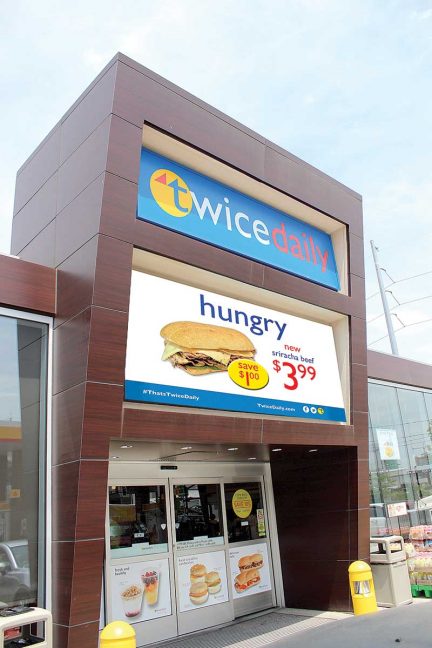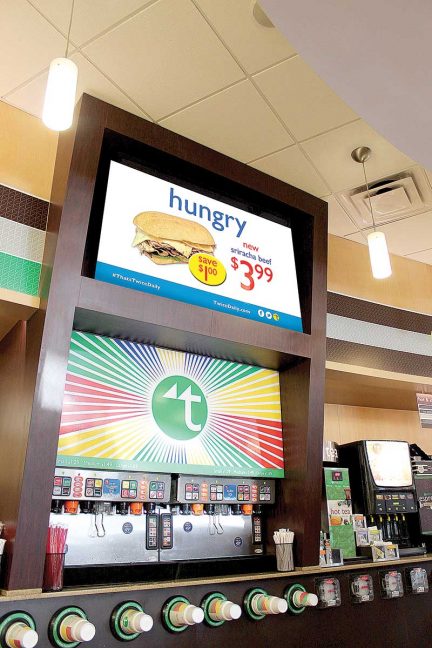by Alissa Marchat/staff writer
Sixty-three percent—that’s how many c-store customers “drive up, fuel up and then they drive away without ever going inside the store,” said Bob Bradley, CEO of software-centric media and merchandising company NewsBreak.
But Bradley and his team believe that their smart merchandising platform, SHEP, can solve that problem for c-store operators. A proprietary software, SHEP automatically creates merchandising playlists for c-store and grocery retailers based on key consumer buying variables, as well as local market variables. The playlists combine merchandising messages with local news and weather at the pump and, according to NewsBreak, SHEP has “been extremely successful in converting fuel-only customers into multi-product purchasers,” with individual retailers seeing anywhere from single- to quadruple-digit increases in unit sales percentages for promoted products.
Based in Tennessee, NewsBreak has partners in four additional states—Georgia, Kentucky, Utah and California—with expansion throughout Silicon Valley and the Rocky Mountain region in the works. Designed to be scalable, SHEP can work for both individual stores and for c-store or grocery chains of any size.
How does it work?
 Bradley and Brian Nelson, COO, spoke with The Shelby Report to provide some insights into how SHEP works to move customers from the forecourt to the store.
Bradley and Brian Nelson, COO, spoke with The Shelby Report to provide some insights into how SHEP works to move customers from the forecourt to the store.
NewsBreak starts by sitting down with a retailer and creating a library of SKUs for the software to draw from and creating “policies,” or rules, for SHEP to follow, Bradley said. Those policies determine which products are advertised at the pump at any given time or location.
“For example, we’ll assign a policy to a hot cocoa spot that may only play at 40 degrees and below. Or maybe it’s a cappuccino ad that will only play between 6 a.m. and 11 a.m. with temperatures below 40 degrees in a neighborhood with a household income of $75,000-plus. Each c-store retailer has its own library of video assets, and the software will go out and grab an asset from the library based on variables like time of day, temperature, weather conditions and household income in a neighborhood, and insert it into the playlist,” he said.
Retailers using SHEP can exert as much or as little control over the playlists as they want, Nelson said.
“If the retailer wants our system to take over completely and tee up assets based on these key consumer buying variables and existing and dynamic sales data, they can let the system take complete control of the network and scheduling. That said, we run across convenience stores or grocery chains that want to focus on specific items or specific sections of their stores,” he said. “If they want to do that, we can tailor the system to either make the software focus on those products in that particular section, or we can dictate that it always runs a particular item for the next month because that item is on a promotion, or there’s excessive inventory, or for whatever reason.”
SHEP also connects with c-store operators’ data warehouses, like those provided by PDI, Bradley pointed out. By monitoring that data, NewsBreak and its customers can track the effectiveness of their merchandising spots. “If we’re finding out that a spot is not really moving unit sales or helping with market basket sales, SHEP will switch it out.”
As SHEP runs, taking the consumer buying variables and sales data into account, it also becomes “smarter,” Bradley said, learning over time which spots are most effective at a given time and place. This is thanks in part to SHEP’s ability to transition from working with historical data to dynamic data.
“Right now there’s a back and forth happening in retail and in data analytics around the difference between the use of static or historical data vs. dynamic data or real-time data,” said Nelson. “We tried to create somewhat of a hybrid in that we’ll build a proprietary algorithm for a retail chain based off of static data—six months, one year, depending on how much we need to ingest. And we adjust that algorithm based on dynamic data.”
Proven sales increases
To help retailers understand just how much of an effect SHEP is having on the sales of a particular item, NewsBreak conducts studies using control groups “to carve out as much noise as statistically possible,” said Nelson, who has a background in statistical research and experimental psychology. To determine SHEP’s effectiveness, NewsBreak instructs a chain’s control stores not to utilize any kind of media or promotions for items that SHEP is merchandising at test stores. NewsBreak also accounts for external variables like fluctuations in weather or fluctuations in one store’s general sales over another, Nelson added.
 “For instance, one of our stores, Twice Daily, has a chicken salad sandwich that they rolled out—a proprietary product,” he said. “And we randomly assigned half of their stores to the control group, half to the test group, and ran strictly branding ads promoting ‘did you know we have the best chicken salad sandwiches in town?’ They weren’t allowed to put a promotional price against it, and they weren’t allowed to put any other advertising or marketing in the area to promote the product. And over the course of 16 weeks, we adjusted whether or not a store was a control group vs. a test store, and consistently, we saw a 21 percent average increase in unit sales.”
“For instance, one of our stores, Twice Daily, has a chicken salad sandwich that they rolled out—a proprietary product,” he said. “And we randomly assigned half of their stores to the control group, half to the test group, and ran strictly branding ads promoting ‘did you know we have the best chicken salad sandwiches in town?’ They weren’t allowed to put a promotional price against it, and they weren’t allowed to put any other advertising or marketing in the area to promote the product. And over the course of 16 weeks, we adjusted whether or not a store was a control group vs. a test store, and consistently, we saw a 21 percent average increase in unit sales.”
While not necessarily the norm, some of SHEP’s most dramatic sales increases have ranged from a 48 percent increase in sales of Red Bull to a 1,000 percent increase in sales of 3 Second Health, a liquid vitamin supplement.
Additional benefits
SHEP can help increase a retailer’s bottom line in multiple ways, Bradley pointed out. In addition to moving forecourt customers to the store and increasing sales of select items, it also can help retailers mitigate waste, especially those with a foodservice program. “We do so much modeling on the existing data, we can help (retailers) understand when products are selling, and when they need to make more meatloaf sandwiches or fill in the blank,” he said. By tracking sales data, SHEP is able to monitor when there is a potential overstock that could lead to shrink, and based on the policies in place for the algorithm, it can insert a spot to help push that item before it goes to waste.
*Editor’s note: This appears as part of the C-Store Feature, which can be found in its entirety in the October print editions of The Shelby Report.






